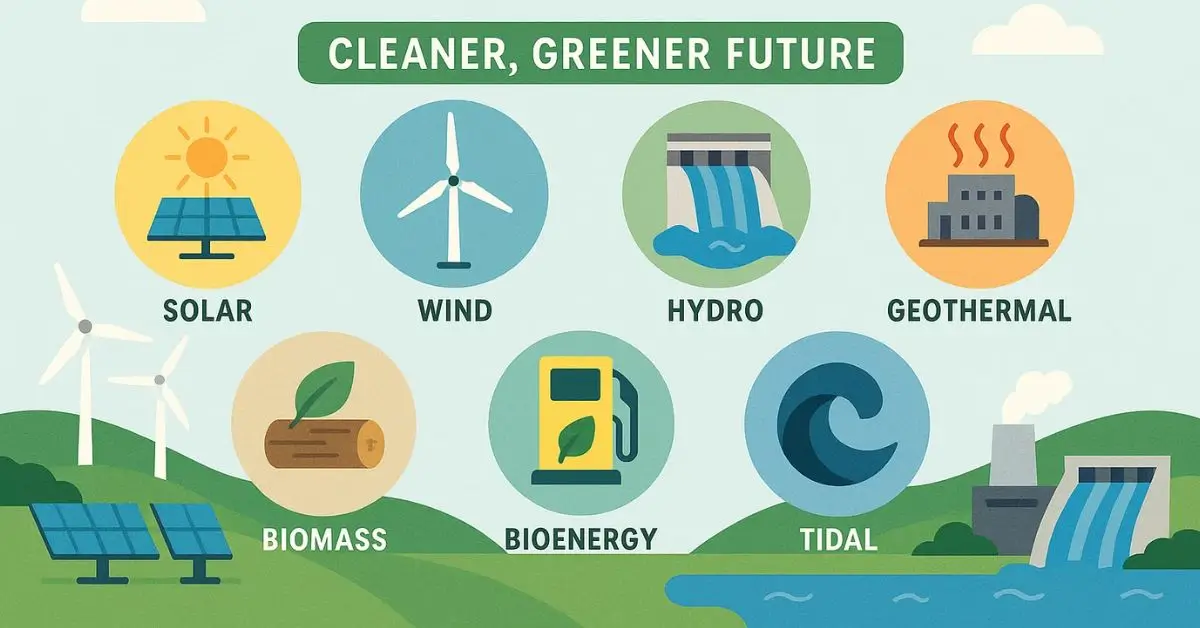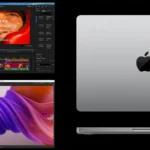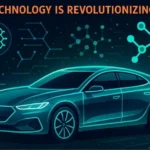Hey, eco-warriors and energy-curious minds! Imagine a world where your morning coffee is powered by the sun, your commute runs on wind, and your Netflix binge is guilt-free because the Earth itself fuels it. That’s the renewable energy revolution happening right now . With global renewable capacity hitting 3,400 GW last year (and growing 10% annually), the shift from fossil fuels isn’t just trendy — it’s essential.
If you’ve ever wondered, “What are the types of renewable energy?”, you’re in the right place.
Table of Contents
Table of Contents
This isn’t your boring textbook rundown. We’re diving deep into seven major types of renewable energy — from the classics like solar and wind to rising stars like green hydrogen and tidal power — with real-world examples, breakthroughs, pros, cons, and even a few “wait, that’s renewable?!” moments.
Whether you’re a homeowner eyeing solar panels or just someone who wants to understand the buzz around “net-zero,” this guide breaks it all down in plain English. Let’s power up! (hstech.io)
Why Renewable Energy Matters More Than Ever
Before we jump into the types, let’s set the stage. The world added 510 GW of renewable capacity in 2024 alone — enough to power Germany, France, and the UK combined. Why the rush?
- Climate crisis: Renewables cut CO₂ emissions by 2.4 billion tons annually — equivalent to removing 500 million cars from the road.
- Energy security: No more oil wars — the sun and wind don’t need pipelines.
- Jobs boom: The sector now employs 13.7 million people globally — more than coal and gas combined.
- Cost crash: Solar energy is now 89% cheaper than it was in 2010. Wind? Down 70%.
Now, let’s meet the seven types of renewable energy powering our future.
1. Solar Energy – The King of Rooftops
How it works: Photovoltaic (PV) panels convert sunlight into electricity using silicon cells. No moving parts, no noise — just pure photon magic.
Pros:
- Works anywhere with sunlight (even cloudy Germany!)
- Scalable: From phone chargers to gigawatt farms
- Lifespan: 25–40 years
Cons:
- Intermittent (no sun = no power)
- High upfront cost (but dropping fast)
- Recycling challenges for old panels
Fun Fact: The Bhadla Solar Park in India (2.7 GW) is now the world’s largest solar farm — visible from space!
2. Wind Energy – Harvesting the Planet’s Breath
How it works: Giant turbines with blades (up to 220 meters wide!) spin generators when the wind blows. Onshore or offshore — both are booming.
- Floating offshore wind (like Hywind Tampen in Norway) unlocks deep-water sites.
- Airborne wind energy (such as kites at 1,000m altitude) could reduce costs by 50%.
- Recyclable blades (Siemens Gamesa) solve the “blade graveyard” problem.
Pros:
- Cheapest new electricity in many regions
- Offshore wind: 40% higher capacity factor than onshore
- Minimal land use
Cons:
- Visual/noise impact (NIMBY issues)
- Bird/bat collisions (mitigated with AI + paint)
- Intermittent (but predictable)
Did You Know? A single 15 MW offshore turbine can power 20,000 homes.
3. Hydropower – The OG Renewable
How it works: Flowing water spins turbines in dams or run-of-river systems. It’s been around since 1882 — and still generates 16% of the world’s electricity.
- Pumped hydro storage = the world’s largest battery (95% of energy storage!).
- Small-scale hydro for rural communities.
- Fish-friendly turbines reduce ecological harm.
Pros:
- Dispatchable (on-demand power)
- Long lifespan (80–100 years)
- Flood control + irrigation bonuses
Cons:
- Ecosystem disruption (dams block fish migration)
- High upfront cost + displacement
- Drought vulnerability
Iconic Example: Three Gorges Dam (China) — 22.5 GW, powers 60 million people.
4. Geothermal Energy – Earth’s Inner Heat
How it works: Hot water/steam from underground reservoirs spins turbines. Think Yellowstone, but with power plants.
- Enhanced Geothermal Systems (EGS) drill into hot dry rock — 100x more potential than traditional sites.
- Geothermal heat pumps for homes: 400% efficiency
Pros:
- 24/7 baseload power
- Tiny land footprint
- Heating + cooling dual-use
Cons:
- Location-specific (best near tectonic plates)
- High drilling costs
- Risk of induced seismicity (rare)
Incredible Stat: Iceland gets 100% of its electricity and heating from geothermal and hydro sources.
5. Biomass & Bioenergy – Trash to Treasure
How it works: Burn organic waste (wood, crop residue, manure) or convert it to biogas/biodiesel. It’s carbon-neutral if regrown sustainably.
- Algae biofuels: 10x yield vs. corn ethanol.
- Waste-to-energy plants with carbon capture.
- Biochar: Locks carbon in soil for 1,000 years.
Pros:
- Uses waste (landfills, thank you)
- Dispatchable (unlike solar/wind)
- Rural job creator
Cons:
- Air pollution, if not filtered
- Land use competition with food
- Deforestation risk
Mind-Blower: Denmark utilises district heating for its cities, utilising straw and wood chips.
6. Tidal & Wave Energy – The Ocean’s Pulse
How it works: Tides (predictable) or waves (constant) drive underwater turbines. The ocean covers 70% of Earth — why not tap it?
- MeyGen (Scotland): World’s most enormous tidal array (6 MW, expanding to 398 MW).
- Wave carpets (flexible mats) survive storms.
- Tidal lagoons double as flood barriers.
Pros:
- 100% predictable (tides = lunar clock)
- Minimal visual impact
- High energy density
Cons:
- Harsh marine environment (corrosion)
- High capex
- Early-stage tech
Wow Factor: One tidal turbine = the power of 60 wind turbines in a smaller space.
7. Green Hydrogen – The Future Fuel?
How it works: Electrolysis splits water (H₂O) into hydrogen + oxygen using renewable electricity. Burn it or use it in fuel cells — zero emissions.
- Over 1,200 projects globally, with $500 billion invested.
- Pink hydrogen (nuclear-powered) and turquoise (methane pyrolysis) are emerging.
- Hydrogen planes (Airbus ZEROe) by 2035.
Pros:
- Stores renewable energy long-term
- Decarbonises steel, shipping, and aviation
- No CO₂, just water vapour
Cons:
- 70% energy loss in production
- Expensive electrolyzers
- Infrastructure lag
Vision: Australia’s H2 export hubs aim to be the “Saudi Arabia of green hydrogen.”
Renewable Energy Comparison: Which Type Wins?
| Type | Reliability | Scalability | Eco Impact |
|---|---|---|---|
| Solar | ☀️ Intermittent | Global | Low |
| Wind | 🌬️ Intermittent | High | Low-Med |
| Hydro | Reliable | Regional | Med-High |
| Geothermal | 24/7 | Limited | Very Low |
| Biomass | Reliable | Medium | Med |
| Tidal/Wave | Predictable | Early | Low |
| Green H₂ | Storage | Growing | Zero |
How to Choose the Right Renewable for You
- Homeowner? → Solar + battery (e.g., Tesla Powerwall)
- Rural area? → Small wind or micro-hydro
- Investor? → Offshore wind or green hydrogen funds
- Policy maker? → Pumped hydro + grid upgrades
The Future: A 100% Renewable World by 2050?
The IEA says yes — if we triple investment to $4 trillion/year. Key enablers:
- AI-optimized grids
- Vehicle-to-grid (V2G) tech
- Space-based solar (beaming energy from orbit — wild, but in trials!)
Your Renewable Action Plan (Start Today!)
- Audit your energy → Use Google’s Project Sunroof for solar potential.
- Switch providers → Choose 100% renewable plans (e.g., Octopus Energy, Arcadia).
- Advocate → Support policies via CREO or local groups.
- Learn more → Watch “The Future of Energy” on YouTube (2025 update).
Final Charge: The Power is Yours
The types of renewable energy aren’t just tech — they’re a movement. From the sun on your roof to the tides in your harbour, clean power is accessible, affordable, and fantastic.
Which type excites you most? Solar on your home? Wind in your state? Drop a comment — let’s talk energy!



